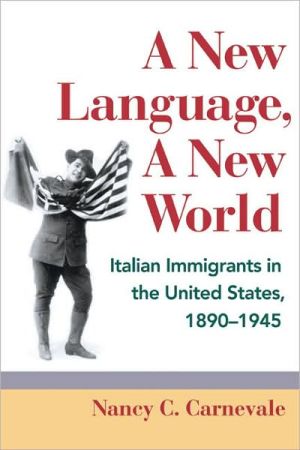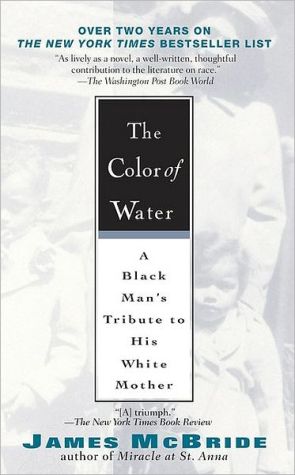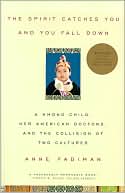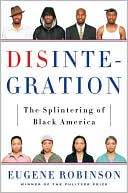New Language, A New World: Italian Immigrants in the United States, 1890-1945
An examination of Italian immigrants and their children in the early twentieth century, A New Language, A New World is the first full-length historical case study of one immigrant group's experience with language in America. Incorporating the interdisciplinary literature on language within a historical framework, Nancy C. Carnevale illustrates the complexity of the topic of language in American immigrant life. By looking at language from the perspectives of both immigrants and the dominant...
Search in google:
An insightful history of Italian immigrants' personal experience of language in America.
A New Language, A New World\ Italian Immigrants in the United States, 1890–1945 \ \ By NANCY C. CARNEVALE \ UNIVERSITY OF ILLINOIS PRESS\ Copyright © 2009 Nancy C. Carnevale\ All right reserved.\ ISBN: 978-0-252-03403-9 \ \ \ Chapter One\ The Italian Languages in Italy and America \ A language is a dialect that has an army and a navy and an air force; that is the only difference really from a linguistic point of view. —Gianrenzo Clivio, sociolinguist\ Italian immigrants who came to America during the era of mass migration brought with them a long and complicated linguistic history that would inform their experiences of language in the New World. Language was a central preoccupation of the literate classes that predated the establishment of the Italian state by several centuries. As the title of this chapter suggests, there was no single Italian language in Italy or in America. The Italian peninsula was and is home to numerous dialects. What came to be known as Italian is the Florentine dialect that eventually achieved the status of a language. For centuries prior to the de facto establishment of a national language and the slow process of its diffusion, the number and distinctiveness of the dialects spoken throughout Italy made it difficult and sometimes impossible for people from different areas to communicate. The lengthy period of debate beginning in the sixteenth century on the need to establish a common language along with the problems created by the profusion of dialects—la questione della lingua—emblazoned the subject of language onto the Italian national consciousness.\ Italy's language question was further complicated by matters of class and race. Because standard Italian was known for centuries to only a small, elite segment of Italian society, the issue of language was infused with a powerful class dimension. A deep North-South divide has long pitted a more developed North against a socially and economically lagging South; northerners, along with some southern intellectuals, believed southerners were inherently inferior to northerners. This longstanding split lent the southern dialects an added racial stigma. The association of standard Italian with the educated elite and of the southern dialects with a racially lesser people exercised a stranglehold on the linguistic imagination of the immigrants. Southern Italians arrived in America with an acute awareness of their linguistic inferiority that only compounded their struggles with language acquisition in their adopted land. The predominantly southern Italian immigrants, possessing command of only their local dialects, found themselves isolated not only from Americans, but also often from their fellow Italians. They compensated by developing their own idiom, an Italo-American dialect, that enabled them to communicate with other Italians while forming and expressing a new identity.\ Language and Nation in Italian History\ Italy was late to the join the ranks of European states, achieving unification through the political and military struggle known as the Risorgimento only in 1861. The political, cultural, and economic fragmentation that characterized the area for centuries prior to unification was mirrored by the plethora of dialects spoken throughout the peninsula. During the rule of the Roman Empire, a variety of peoples from both Indo-European and non–Indo-European linguistic groups coexisted. The Romans were tolerant of other languages and the various ethnolinguistic groups remained culturally and linguistically independent of Rome. That Roman elites along with some slaves were bilingual in Latin and Greek both reflected and supported the linguistic diversity of the Roman Empire.\ Other political and natural features of the Italian peninsula contributed to its exceptional linguistic diversity. Exercising its influence from Rome, the Catholic Church reinforced existing political and related ethnolinguistic divisions on the Italian peninsula at various times. In 323, the Council of Nicea favored the continuation of Roman administrative partitioning that invested power locally. The lack of a political center for so many years contributed to the linguistic diversity of the area. Later, with the Council of Tours in 813, the church sanctioned the use of local idioms by priests to communicate with the lay public, further contributing to the spread of vulgar forms of Latin, the precursors of the Italian dialects. In the ongoing absence of a centralized government, there was no entity to impose a standardized language, nor did other institutions or traditions exist that might have led to the rise of a dominant language such as elementary level schooling or an emphasis (as in Protestant countries) on reading the bible and other sacred texts. The rise in the late Middle Ages of powerful city-states accorded prestige to the speech of each one, thus accentuating language differences between rival political and cultural centers. Geography too played its part. The natural barriers within Italy resulted in the isolation of individual communities, contributing to the development of numerous and distinct languages. At the same time, its accessibility by sea and through mountain passes made Italy an inviting target for invaders who introduced their own linguistic influences beginning with the fall of the Roman Empire.\ It was not until the fourteenth century that the roots of what would become modern Italian were established in Florence. The literary flourishing of vernacular works, notably by the legendary triumvirate of Petrarch, Boccaccio, and Dante, created the basis for a written lingua franca, if only for Italian elites. Dante, who self-consciously determined to write his Divinia Commedia in Florentine to help establish it as a common vernacular, was particularly influential. Even though fourteenth-century Florentine eventually became the basis for the standard language, the debate on which language to use as a common medium for communication did not begin in earnest until the 1500s, prior to which most administrative and legal documents, as well as literary and scholarly works continued to be written in Latin. The sixteenth-century majority view, represented by the Venetian humanist scholar and poet Pietro Bembo, gave preference to fourteenth-century written Florentine as opposed to then contemporary Florentine. He and others believed that literary language should not resemble everyday speech. The Florentine dialect was chosen because it was better understood than other dialects and was closer to Latin, making it comprehensible to at least the elite classes throughout Italy. The economic dominance that Florence enjoyed from the fourteenth through the sixteenth centuries also helped solidify its position as the linguistic capital of what would become Italy. Already by the end of the sixteenth century, Florentine had become the language of Rome, the largest and most cosmopolitan of the Italian cities of the time. Yet throughout the rest of Italy, Italian was little known. As late as the period of unification, only between 2.5 and 12 percent of the newly established nation's entire population knew Italian.\ The absence of a common language at the time of unification and the continued use of the dialects meant that the questione della lingua would become central to the new nation. Italy's intellectuals hotly debated the issue of language in the early years of the Risorgimento. Author Alessandro Manzoni stimulated these debates when he turned the focus away from the written fourteenth-century Florentine used by Italy's elites to the Florentine language as it was spoken in his day. Manzoni argued that uso (usage) should take precedence above all and, given the historical association of the Italian language with Florence, contemporary Florentine was best suited to become the national language, uprooting the malerba dialettale (dialect weeds). His novel, I promessi sposi, was written in nineteenth-century Florentine and served as "a kind of linguistic gospel" during the era of unification.\ The opposing view was represented by Graziadio Isaia Ascoli, a language scholar who contended that from a purely historical perspective, Italy already had a national language in the written fourteenth-century Florentine and it would be artificial to impose any other language or version of the original. Nor was the eradication of dialects in favor of the national language necessary or desirable. Ascoli and others maintained that the dialects were part of the nation's cultural heritage and could coexist with a national language. By the 1880s, Manzoni's detractors had won. The language of Dante effectively became the language of state and civil society, although the Italian language was never enshrined in law, and historically, Italy has exhibited a tolerance of linguistic minorities that was formalized with the 1948 constitution.\ Yet Italy's language question did not end with the designation of a standard language. The vast majority of the population continued to use their dialects and remained unable to speak Italian, as the Florentine dialect came to be known, although some had a passive knowledge of the language. Outside of Rome and Tuscany, even the well-educated continued to use elements of dialect along with local pronunciations. This situation ensured that the issue of language would continue to be a national preoccupation for years to come.\ Over time, the social, economic, and political changes wrought by unification contributed to the spread of Italian and the weakening of the dialects. Building on the introduction of limited free primary education in 1859, the Coppino Act of 1877, which mandated elementary school education for children over the age of nine, helped to diffuse the language, albeit slowly and unevenly. Industrialization led to the rapid growth of cities that drew immigrants from all over Italy. The need for people from diverse areas to communicate encouraged the use of Italian. The creation of a national bureaucracy and a standing army further encouraged the abandonment of dialects in favor of the national language. The expansion of the press and the growth and availability of theater and other forms of mass entertainment that later included television and radio further eroded dialect use in favor of Italian.\ Although internal migration facilitated the diffusion of Italian, the vast emigration of Italians during the Age of Migration slowed its spread. Ironically, the emigration of those who were least likely to know the language—poor, young, illiterate men, and especially southerners—slowed the diffusion of Italian by removing the emigrants from Italian society before they had the opportunity to learn the standard language and contribute to its spread. In other ways, however, emigration stimulated the spread of Italian. The remittances men sent home to their families helped revitalize rural areas, especially in the South. Schools benefited from this economic stimulation, resulting in more children learning Italian. In addition, the numerous returning immigrants from the United States, having experienced firsthand the hardships of illiteracy while away from home, came back to Italy with a newfound sense of the importance of education. Enrollment in adult and elementary schools boomed in the early 1900s as the emigrants returned to Italy to establish themselves with money earned abroad or to sojourn temporarily in their homelands before emigrating again in search of work. In Sicily, for example, elementary school enrollment rose from 54.5 percent around 1901 to 73.5 percent just five years later, and female enrollment in both Sicilian elementary and adult schools rose significantly as women were faced with new responsibilities and opportunities in the wake of male migration. The areas that saw the greatest numbers of emigrants—including most southern provinces—saw the greatest reductions in the rates of illiteracy. The United States' continual threat to impose a literacy test on immigrants, beginning in the 1880s, spurred the Italian government to offer literacy classes that were attended by potential emigrants. Although knowledge of the standard language in and of itself invariably contributed to the decline in the use of dialects, the schools were self-consciously engaged in eradicating dialect usage despite voices of opposition. Even if the schools were supposed to promote the use of Italian at the expense of the dialects, in practice, teachers still tended to use their own dialects in the classroom. This situation prompted Manzoni's proposal to send teachers from Tuscany throughout Italy.\ Even though unification created the conditions for the diffusion of Italian, there were many obstacles. By one estimate, at the time of unification, fully 31 million of the newly formed nation's 35 million inhabitants did not know the national language. Even with the implementation of compulsory elementary education and the formal attempt to teach Italian, most people did not acquire Italian unless they went beyond the elementary level, an uncommon practice at the time given the grinding poverty with which most Italian families had to contend. A mere 4 percent of the population attained postelementary education in 1911 and even as late as 1931, only 15 percent of the population had a high school education. The schools were underfinanced for years and the absence of an overarching bureaucratic entity to oversee and implement the diffusion of Italian ensured that the process would be slow and inconsistent. Indeed, Italian only became a mother tongue to large numbers of Italians beginning with those born after 1950. Even today, despite the widespread diffusion of the standard language, many Italians are bilingual with fluency in both their local dialects and Italian.\ Language continued to be high on the national agenda well into the twentieth century. During the Fascist era, language figured prominently in both the internal and external fascist goals and programs from the 1920s until Mussolini's fall in 1943. The imposition of a national language—fourteenth-century Florentine with a Roman pronunciation—was crucial to the Fascist project of fostering nationalistic fervor. To this end, the government promulgated a mythologized linguistic history that claimed a direct link between Latin, the language of ancient Rome that Mussolini idealized, and Dante's written Florentine. In her study of linguistic policies under Fascism, Gabriella Klein notes three forms of linguistic interventions within Italy during the reign of Fascism. First, in an effort to standardize the language, the government attempted to do away with the use of dialect or regionalisms of any kind, particularly in the schools. Second, language was linked to nationalism as evidenced by efforts to linguistically assimilate ethnic minorities within Italy and a generalized hostility toward minority languages. Finally, a kind of linguistic xenophobia erupted. An example was the government policy of dubbing foreign films into Italian so that Italians would not be exposed to any outside languages, an unfortunate practice that continues to this day. Even the names of non-Italian actors were Italianized. Fred Astaire, for example, was known to Italians as Federico Astorio. For all of Mussolini's efforts, however, dialect usage did not decline significantly.\ Initially, the Fascist repudiation of the dialects was shared by the Italian Left, with some notable exceptions. Antonio Gramsci, a linguist by training and a southerner who was born and raised in Sardinia, appreciated the need for a standard language. He believed that dialect speakers, who had little or no knowledge of the standard language, necessarily held parochial worldviews and so were limited in their ability to understand ideas that originated in a language of the larger world. Moreover, the lack of a common language facilitated the exploitation of the northern proletariat and southern peasants who the elites of both areas were able to set against each other. Despite his belief in the need for a common language, he rejected the Manzonian idea of superimposing an essentially foreign language onto dialect speakers. In the Italian case, the standard language based on the Florentine dialect also reinforced the dominance of the industrial North over the less developed South. Rather than forcing the use of a literary Florentine that was shaped by and that expressed a particular lived experience that is unknowable to those outside of that linguistic domain, Gramsci believed in the possibility of forming a new "normative grammar" in the interplay between existing languages (dialects) within Italy. In this way, a common language would emerge directly from the people, though it is not clear how he proposed to overcome the considerable barriers to such linguistic intermixing in Italy.\ (Continues...)\ \ \ \ \ Excerpted from A New Language, A New World by NANCY C. CARNEVALE Copyright © 2009 by Nancy C. Carnevale. Excerpted by permission of UNIVERSITY OF ILLINOIS PRESS. All rights reserved. No part of this excerpt may be reproduced or reprinted without permission in writing from the publisher.\ Excerpts are provided by Dial-A-Book Inc. solely for the personal use of visitors to this web site. \ \
Contents\ Acknowledgments....................ix\ Introduction....................1\ 1. The Italian Languages in Italy and America....................21\ 2. Linguistic Boundaries in American History....................43\ 3. "He could not explain things the way I tell it": The Immigrant in Translation....................79\ 4. The World Turned Upside Down in Farfariello's Theater of Language....................114\ 5. The Identity Politics of Language: Italian Language Maintenance in New York City, 1920–40....................136\ 6. Language, Italian American Identity, and the Limits of Cultural Pluralism in the World War II Years....................158\ Epilogue....................179\ Notes....................185\ Index....................237
\ From the Publisher \ "Carnevale takes a fresh and intriguing approach by focusing on an issue to which historians have devoted surprisingly little attention."--Journal of American Ethnic History\ \ \








